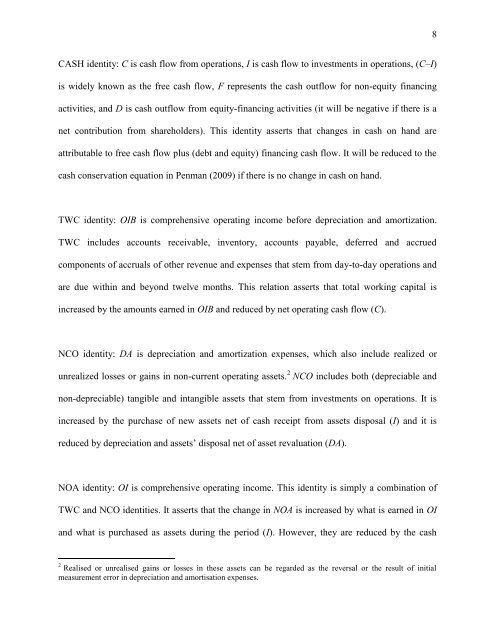Modelling the accruals process and assessing unexpected accruals*
Modelling the accruals process and assessing unexpected accruals*
Modelling the accruals process and assessing unexpected accruals*
You also want an ePaper? Increase the reach of your titles
YUMPU automatically turns print PDFs into web optimized ePapers that Google loves.
CASH identity: C is cash flow from operations, I is cash flow to investments in operations, (C–I)<br />
is widely known as <strong>the</strong> free cash flow, F represents <strong>the</strong> cash outflow for non-equity financing<br />
activities, <strong>and</strong> D is cash outflow from equity-financing activities (it will be negative if <strong>the</strong>re is a<br />
net contribution from shareholders). This identity asserts that changes in cash on h<strong>and</strong> are<br />
attributable to free cash flow plus (debt <strong>and</strong> equity) financing cash flow. It will be reduced to <strong>the</strong><br />
cash conservation equation in Penman (2009) if <strong>the</strong>re is no change in cash on h<strong>and</strong>.<br />
TWC identity: OIB is comprehensive operating income before depreciation <strong>and</strong> amortization.<br />
TWC includes accounts receivable, inventory, accounts payable, deferred <strong>and</strong> accrued<br />
components of <strong>accruals</strong> of o<strong>the</strong>r revenue <strong>and</strong> expenses that stem from day-to-day operations <strong>and</strong><br />
are due within <strong>and</strong> beyond twelve months. This relation asserts that total working capital is<br />
increased by <strong>the</strong> amounts earned in OIB <strong>and</strong> reduced by net operating cash flow (C).<br />
NCO identity: DA is depreciation <strong>and</strong> amortization expenses, which also include realized or<br />
unrealized losses or gains in non-current operating assets. 2 NCO includes both (depreciable <strong>and</strong><br />
non-depreciable) tangible <strong>and</strong> intangible assets that stem from investments on operations. It is<br />
increased by <strong>the</strong> purchase of new assets net of cash receipt from assets disposal (I) <strong>and</strong> it is<br />
reduced by depreciation <strong>and</strong> assets‟ disposal net of asset revaluation (DA).<br />
NOA identity: OI is comprehensive operating income. This identity is simply a combination of<br />
TWC <strong>and</strong> NCO identities. It asserts that <strong>the</strong> change in NOA is increased by what is earned in OI<br />
<strong>and</strong> what is purchased as assets during <strong>the</strong> period (I). However, <strong>the</strong>y are reduced by <strong>the</strong> cash<br />
2 Realised or unrealised gains or losses in <strong>the</strong>se assets can be regarded as <strong>the</strong> reversal or <strong>the</strong> result of initial<br />
measurement error in depreciation <strong>and</strong> amortisation expenses.<br />
8



